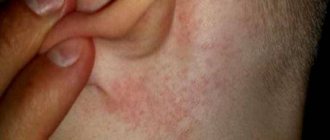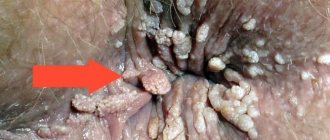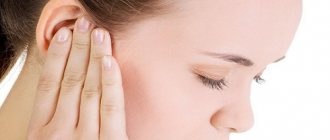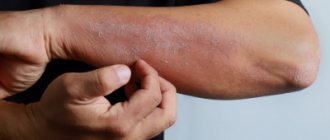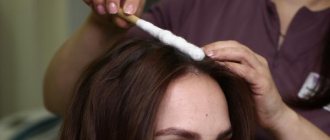Make an appointment with an ENT doctor by phone or by filling out the online form
| Select a clinic | ENT | ENT at home | Ear swab |
Itching and flaking in the ear
accompanies many diseases of this organ. These can be a variety of infections and fungal diseases, allergies, and so on. Therefore, it is necessary to know the possible causes of this condition and try to avoid them.
If similar manifestations appear in someone close to you or in you, you should contact an ENT specialist. An otolaryngologist, or as he is called for short - ENT, deals with the treatment, prevention and diagnosis of diseases of the ear, nose and throat. All these organs are interconnected, which means that pathogens that cause diseases can penetrate from one to another, leading to the spread of diseases. That is why any ENT diseases must be treated in a timely manner.
Feature of the violation
Crusts in a person’s ears can appear for a variety of reasons, ranging from microtrauma to dangerous inflammatory processes. They often appear in infectious diseases, psoriasis, dermatitis, and many other problems.
In addition to diseases, mechanical damage can provoke such a disorder. These include microtraumas that can occur due to improper hygiene, as well as more serious injuries resulting from direct or indirect impact on the ears.
In any case, damage to the skin is observed, as a result of which blood plasma leaks through the cells, dries out, and crusts form. Their features largely depend on the ongoing pathology. It is very important to determine in a timely manner why crusts form in the ear, and also try to deal with the existing problem as quickly as possible.
Treatment
The affected areas are wiped with alcohol or ether, powdered with talc or zinc oxide, the skin is irrigated with an oxycort aerosol, and for peeling, hecortone, celistoderm with garamycin are used.
Make an appointment right now!
Call us by phone or use the feedback form
Sign up
Removal of crusts is carried out only after wetting them with vegetable oil or Vaseline. After this procedure, oxytetracycline or prednisolone ointment is applied. In addition to drug treatment, ultraviolet training (UVR), laser therapy sessions, ultrasonic medicinal irrigation, and UHF are prescribed.
Main types
The crust in the ear may vary depending on the type of pathogen and location. It can be caused by diseases such as:
- ear candidiasis;
- maringitis;
- psoriasis;
- seborrheic dermatitis;
- neurodermatitis;
- eczema.
Ear candidiasis occurs due to yeast infection. As a result of this, not only crusts appear in the ear canal, but also a characteristic odor. Such a lesion is localized on the middle and outer ear, as well as behind the auricle.
Maringitis or eardrum infections is a fungal process that can occur due to mechanical damage.
If crusts appear in the ears (photo below), this may be due to many skin diseases, each of which requires a special treatment method. One of these diseases is psoriasis. It is characterized by damage to the surface of the skin. Red nodules are formed on it, which are covered with white scales. Initially, the nodules are small and then become large, forming plaques.
Neurodermatitis is a skin disease that manifests itself as a rash and severe itching. Redness appears on the affected area and peeling begins. In the advanced stage, the skin darkens, blisters form on it, after which a dried crust remains.
Diagnostics
Taking into account the medical history and such characteristic manifestations of the disease as weeping, redness, thickening of the skin, crusting or peeling, diagnosing the disease does not cause difficulties. The acute form of eczema must be differentiated from erysipelas of the external ear and fungal external otitis. With erysipelas, there is no itching, the boundaries of inflammation are clearly defined, and palpation of the affected area is sharply painful. In the case of a fungal process, the diagnosis is made after conducting mycological studies.
Causes
There are many reasons why a crust may appear inside the ear. These should include the following:
- diabetes;
- fungus;
- staphylococcus;
- failure to comply with hygiene rules;
- allergy;
- excessive accumulation of sulfur;
- mechanical damage;
- hereditary factor.
Fungal infection is characterized by itching and discharge from the ear canal. With staphylococcus, not only does a crust form in the ear, but a boil also forms or the patient suffers from otitis media. There is also purulent discharge from the ear canal. Excessive cleanliness or poor hygiene can cause peeling of the ears due to the use of cotton swabs. In this case, painful crusts may form in the ear canal. This disorder can be complicated by infectious eczema.
There may also be dandruff in the ears. This disease manifests itself in the form of dry flaking of the skin, the formation of whitish scales, which are very difficult to separate from the epidermis. Sometimes it appears in the form of yellow crusts on the ears of an unkempt appearance. The disease provokes very severe itching.
Peeling can occur on the pinna, inside the ear canal, and on the head behind the ear. Excessive sun exposure can cause sunburn. This can cause crusts to form in the ear and peeling. Also, such a disorder can cause exposure to chemicals on the skin.
Peeling is often associated with poor diet, stress, and infection of the ear canal. When a white crust appears in the ears, a doctor’s consultation and comprehensive treatment are required.
Causes
Discharge from the ear can be short-term and appear after water, foreign objects (small insects, fibers from a cotton swab) or inaccurate cleaning get into the ear. In this case, the ear cleanses itself precisely due to excessive secretions. The process does not take long and is usually painless.
If discharge appears too often, possible causes may be:
- Otitis of the middle ear in acute form: after the abscess breaks through, white thick discharge appears and the pain subsides sharply. It is important that the pus is directed outward and not inward, because the second option is fraught with the development of brain pathologies;
- exacerbation of chronic otitis media of the middle ear: rupture of the eardrum or the presence of cholesteatoma - a benign neoplasm that contains a mixture of dead cells and their waste products;
- CSF (cerebrospinal fluid) leak due to head injury or recent neurosurgery: the discharge is clear or bloody in color;
- otitis of the external ear of an infectious or allergic nature: infectious otitis often appears after swimming, since water, especially in natural reservoirs, contains a large number of pathogenic microorganisms; allergic otitis media is accompanied by severe itching and redness; it happens that both types of otitis develop simultaneously, then the ear canal is completely filled with secretions;
- malignant tumor of the ear canal: discharge is bloody, accompanied by moderate pain;
- foreign bodies mainly end up in the ear of children: the self-cleaning process can lead to inflammation and the formation of pus, with a characteristic unpleasant odor;
- mastoiditis - untreated otitis media: accompanied by fever, redness and pain when pressing on the mastoid process;
- external otitis media with signs of tissue necrosis: the pain is severe, chronic, spreading to the entire ear and the area around it, accompanied by swelling and, in rare cases, weakness of the facial nerves;
- bacterial dermatitis - inflammation of the skin around the ear;
- boil in the ear canal area - inflammation of the sebaceous gland or hair follicle;
- acute form of otitis media;
- rupture of the outer wall of the eardrum (perforation);
- head injury;
- benign neoplasms;
- gross violations when taking medications.
Main symptoms
Yellow and white crusts in the ears are not considered a disease, but merely signal an existing pathology. To make an accurate diagnosis, you need to conduct a thorough examination and determine what other symptoms of the disorder there are. The most common signs observed in the presence of crust in the ears are:
- severe itching – with fungal infections;
- redness – always present in the presence of a crust;
- discharge from the ear is characteristic of otitis, eczema, prickly heat;
- pain – accompanies the inflammatory process;
- increased temperature - occurs with purulent otitis.
Symptoms largely depend on the nature of the pathology and the severity of its course. Almost all otitis media are accompanied by headaches, pain inside the ear, and fever. Fungal infections are characterized by itching, which is constantly present. All attempts to scratch inside the ear lead to microtraumas and aggravation of the pathological process, which is also expressed in the formation of crusts.
Dermatitis and eczema have the ability to affect large areas. Therefore, not only the ear canal, but also the entire auricle becomes the area of crusting and peeling.
When otitis media occurs, causing the formation of a crust in a person’s ears, symptoms such as:
- constant or periodic itching in the ear;
- headache;
- formation of sulfur plug;
- irritation or increased sensitivity of the ear.
In addition, there may be hearing loss and a feeling of fullness in the ears. This symptom is especially pronounced in mycotic otitis media. If the disease is localized in the outer ear, then plugs and crusts form in it, and liquid discharge also appears. Itching may occur in the area behind the ear.
What to do about itching and flaking of the ear?
This symptom cannot be ignored, since it indicates the onset of some disease that must be detected and eliminated as quickly as possible. The “Your Doctor” website will help with this, which will allow you to quickly and easily find an ENT specialist or call an ENT specialist to your home in order to carry out a diagnosis and begin treatment as soon as possible.
Useful information on the topic:
- Diagnosis of itching in the ear
- Itching in a child's ear
- Itchy ears and discharge
- Itching in the ear
- Treatment for itchy ear
- Causes of itching in the ear
This article is posted for educational purposes only and does not constitute scientific material or professional medical advice.
Author:
Mumladze Koba Vazhaevich Anesthesiology and resuscitation
Back to section
Carrying out diagnostics
Before carrying out treatment, it is important to determine exactly why crusts form in the ears, and for this you need to carry out a comprehensive diagnosis. Diagnostic techniques largely depend on the existing symptoms, as well as the severity of the pathological process.
First of all, the doctor conducts a visual examination of the auricle and ear canal, based on which he makes a preliminary conclusion. If the doctor can make a diagnosis immediately, then additional examination is not required. Quickly diagnosed diseases include seborrhea, eczema, and dermatitis. Basically, when they occur, dry crusts form in the ears, photos of which accurately show the peculiarity of the pathology.
In all other cases, especially if otitis media or fungus is suspected, a series of laboratory and instrumental studies must be carried out to make an accurate diagnosis. To determine the presence of pathogenic microorganisms, urine and blood tests are prescribed. To determine the nature of the origin and composition of the crusts, scraping is carried out. Bacterial culture helps determine the nature of the bacteria. If there is inflammation of the inner ear, radiography is prescribed. If a malignant tumor is suspected, a computed tomography scan is required.
Features of treatment
If a crust forms in the ear, this may be due to a general disorder of the body. Therefore, an integrated approach to treating the disease is required. The usual rules of a healthy lifestyle will help you cope with any disease much faster. A full night's sleep and rest, daily walks in the fresh air, and moderate physical activity are recommended.
It is recommended to include whole grain cereals, fruits and vegetables in your usual diet. It is important to consume enough clean water. It is important to provide the body with the required vitamins and minerals by taking special multivitamin complexes.
It is recommended to avoid stressful situations. If this is very difficult to do, then you need to use sedatives. You need to drink them in courses according to the instructions. Every day, 3-5 times a day, you need to wipe the ears with a cotton swab dipped in an oil solution.
Medications
If crusts appear in the ears, how to treat them largely depends on the provoking factor. Treatment for otitis should begin with eliminating the infection. To do this, you need to rinse your ears with a glycerin solution. You also need to stop taking antibacterial and hormonal agents. This will help increase the susceptibility of the pathogen to drugs and accelerate the antifungal effect. Drug therapy includes the use of ointments and instillation of solutions.
Doctors prescribe antifungal ear drops, compresses, lotions and rinses. They are used when it is necessary to eliminate pain, inflammation and destroy pathogenic microflora. For this purpose, Cefazolin, Candibiotic, and Clotrimazole are prescribed.
The duration of treatment is determined by the doctor. Drops can only be used if the inside of the ear is not damaged. Otherwise, you need to use lotions.
A painful type of fungus is ear candidiasis, the symptoms of which require solutions with the appropriate composition. The fungus can be eliminated using such agents as Econazole, Fluconazole, Natamycin. They can be prescribed in the form of ointments and solutions, using as recommended by a doctor.
If you follow all the doctor's recommendations, candidiasis can be completely eliminated, but only if it occurs at an early stage. For an advanced form of infection, systematic treatment with medications in tablet form will be required.
If the fungus is localized outside the ear, then external antifungal drugs are used. These include such as Exoderil, Lamisil, Nitrofungin, Clotrimazole. If the fungus is in the ears, then the ointment is applied after preliminary cleaning.
Folk remedies
When dry crusts form in the ears, only a doctor can determine how to treat it. Folk remedies can enhance the effect of medications. They help relieve pain and itching well. Traditional methods involve the use of medicinal baths, decoctions and tinctures.
Against fungus, you can instill a vinegar solution into the ear. Mix 1:1 table vinegar and hydrogen peroxide. Place 3 drops of the prepared product into the ear daily. The course of treatment is 10 days. This remedy is contraindicated if the fungus is combined with an ear injury.
Garlic can be used to make a medicinal ointment. This remedy is used if the fungus is accompanied by a bacterial infection of the ear. It has strong antiseptic properties. Take 3 medium-sized cloves of garlic, grind to a paste, add 3 drops of olive oil and mix thoroughly. Apply the prepared product onto a cotton swab, insert into the ear and hold for 30 minutes. After the procedure, clean the ear canal.
Geranium ointment provides good results. Initially, prepare the broth, select the inflorescences, add 3 drops of onion juice and 5 drops of tea tree oil. Use as a compress. Aloe ointment is prepared in the same way. Both of these agents have antiseptic and anti-inflammatory effects.
Crusts in a child's ear
A small amount of secretion is produced daily in a child's ear canal. Excess sulfur must be removed. Many parents are interested in how to properly care for their child’s ears in order to avoid various problems and crust formation.
There are many different symptoms that indicate the progression of a baby’s ear disease, namely: pain, unpleasant odor, peeling or redness of the skin. It is important to clean not only the ear, but also behind the ears, as the accumulation of dirt can lead to the development of many problems.
If yellow crusts have formed, this may be a sign of a disease such as scrofula. It refers to one of the manifestations of dermatitis. Among the main symptoms are the appearance of yellow crusts, flaking of the ears and itching. Underneath the scabs, the skin is smooth and moist. After some time, the rash may spread to the head and body. In addition, yellower crusts may appear for reasons such as:
- insufficient hygiene;
- allergy;
- infection with staphylococcus.
It is very important to immediately take your child to a dermatologist or allergist, who will prescribe the correct treatment.
Crusts in the ears can form due to otitis externa. This is a common disease in which an infection enters the external auditory canal. In this case, the ear swells, turns red, and translucent discharge appears. After a while, a crust forms on the surface. If the disease is mild, treatment is carried out using drops, lotions, and ointments.
Clinical picture
At the beginning of the development of the disease, hyperemia (redness) and thickening of the skin of the ear concha and external auditory canal is observed, which occurs due to infiltration. Then the ear canal narrows. Then constant itching occurs in the ears and as a result of scratching, abrasions appear, and then small bubbles with serous fluid form, when opened, weeping is observed and grayish-yellow crusts appear.
If a secondary infection occurs, limited or diffuse external otitis develops. When a patient has serious general diseases, eczema often becomes chronic, and the process penetrates into the deeper layers of the skin. This disease is characterized by frequent relapses.
Friends! Timely and correct treatment will ensure you a speedy recovery!
Carrying out prevention
Since the formation of crusts in the ear is just a symptom, all preventive measures should be aimed at preventing the development of possible diseases. That is why prevention means:
- timely contact a doctor for help;
- increasing immunity;
- proper nutrition;
- eliminating stress;
- preventing hypothermia;
- proper ear hygiene;
- general hygiene.
Most people do not pay attention to the formation of crusts, believing that they are nothing serious. However, this is wrong, since they signal the onset of the disease. At the first signs, you should immediately consult a doctor.

